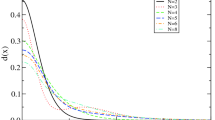Abstract
Matrix elements between shifted correlated Gaussians of various potentials with several form-factors are shown to be analytic. Their gradients with respect to the non-linear parameters of the Gaussians are also analytic. Analytic matrix elements are of importance for the correlated Gaussian method in quantum few-body physics.
Similar content being viewed by others
References
J. Mitroy et al., Theory and applications of explicitly correlated Gaussians. Rev. Mod. Phys. 85, 693 (2013)
S. Bubin, M. Pavanello, W.-C. Tung, K.L. Sharkey, Ludwik Adamowicz, Born-Oppenheimer and non-born-oppenheimer atomic and molecular calculations with explicitly correlated Gaussians. Chem. Rev. 113, 36 (2013)
Mauricio Cafiero, Ludwik Adamowicz, Analytical gradients for Singers multicenter n-electron explicitly correlated Gaussians. Int. J. Quantum Chem. 82, 151159 (2001)
L. Keeper, S.B. Sharkey, L. Adamowicz, An algorithm for calculating atomic D states with explicitly correlated Gaussian functions. J. Chem. Phys. 134, 044120 (2011)
K.M. Daily, H.C. Greene, Extension of the correlated Gaussian hyperspherical method to more particles and dimensionsb. Phys. Rev. A 89, 012503 (2014)
Wei-Cheng Tung, Ludwik Adamowicz, Accurate potential energy curve of the LiH+ molecule calculated with explicitly correlated Gaussian functions. J. Chem. Phys. 140, 124315 (2014)
Sergiy Bubin, Martin Formanek, Ludwik Adamowicz, Universal all-particle explicitly-correlated Gaussians for non-BornOppenheimer calculations of molecular rotationless states. Chem. Phys. Lett. 647, 122 (2016)
X.Y. Yin, D. Blume, Trapped unitary two-component Fermi gases with up to ten particles. Phys. Rev. A 92, 013608 (2015)
M. Galassi et al, GNU Scientific Library Reference Manual–Third Edition (January 2009), ISBN 0954612078
Y. Suzuki, K. Varga, Stochastic Variational Approach to Quantum-Mechanical Few-Body Problems (Springer, Berlin, 1998)
P. Ring, P. Schuck, The Nuclear Many-Body Problem, ISBN 3-540-09820-8 (Springer, Berlin, 1980)
Maxima.sourceforge.net. Maxima, a Computer Algebra System. Version 5.34.1 (2014). http://maxima.sourceforge.net/
Author information
Authors and Affiliations
Corresponding author
Additional information
This article belongs to the special issue “30th anniversary of Few-Body Systems”.
Rights and permissions
About this article
Cite this article
Fedorov, D.V. Analytic Matrix Elements and Gradients with Shifted Correlated Gaussians. Few-Body Syst 58, 21 (2017). https://doi.org/10.1007/s00601-016-1183-0
Received:
Accepted:
Published:
DOI: https://doi.org/10.1007/s00601-016-1183-0




